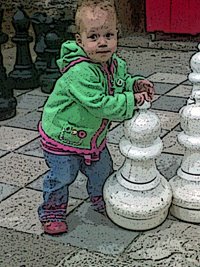
I feel strange pangs of guilt as well as nostalgia playing Tomb Raider: Anniversary. But most of all I just feel a bit irritated. Sure Lara moves better and looks better. But the crates... why has crate navigation become such a pain? They swing about all over the place. Lara I can move like a ballerina as she flips about in combat and hops from pole to pole and wall runs and grapple swings. Give her a crate to push or pull and she's swaying all over the place. I am an often incompetent player -- rubbish at twitch combat, rubbish at complex puzzles, rubbish at the fine timing needed for real fluid grace. But now I have to add incompetence with basic crate handling. Too much like the real world when I can't even lug around heavy objects efficiently.
The game looks good, though (although I am aware there are no crates in the screenshot above). They even paint the textures on the floor to tell me where to place my crates (although I swear that Prince of Persia: The Sands of Time did its visual signposting so much better with just light). I just feel a little let down by the crate management...










